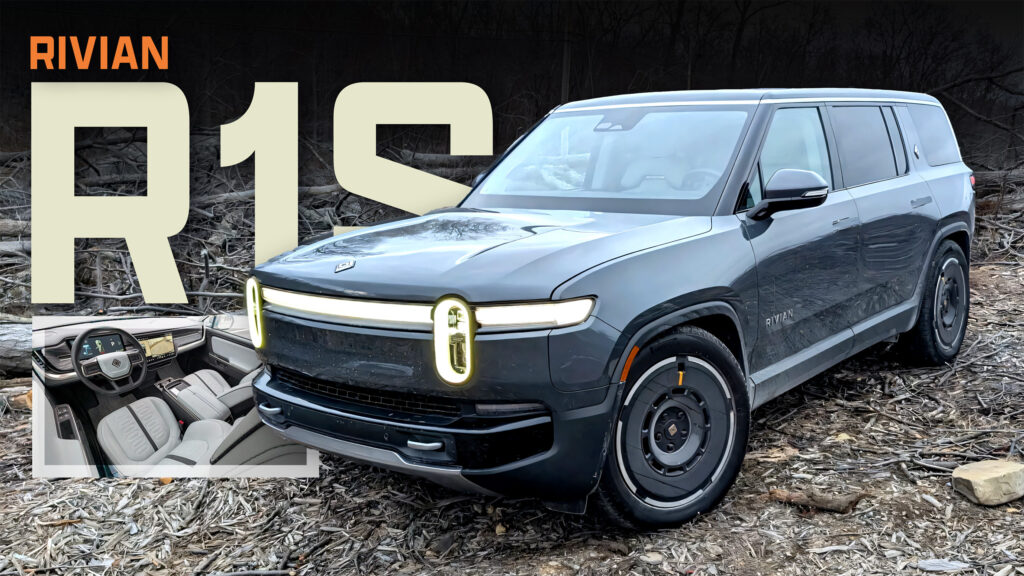Very few automakers sit in the same position as Rivian. Smaller EV startups hope to be as successful as the Normal, Illinois-based company someday. On the other hand, larger brands don’t have to worry too much about Rivian stealing their customers just yet. In 2024, the EV automaker sold just over 51,000 cars in a market that included well over a million total sales.
For Rivian to continue gaining market share, this vehicle, the R1S has to continue to convert customers from other brands. Externally, this middle-size SUV stands out just as much as its parent company does. The shape isn’t wholly boxy or completely square. The headlights are a clear and direct reminder that this isn’t something from Ford, Chevy, Chrysler, or even Tesla.
Review: 2025 Land Rover 110 Defender Is A Go-Anywhere Luxury SUV
What it is, though, is a well-equipped SUV regardless of the trim one might pick. In fact, it’s one of the most configurable, most capable, and most eclectic SUVs this side of a super-luxury six-figure brand like Rolls-Royce, Bentley, or Maybach.
QUICK FACTS
To get a real sense of just how good Rivian’s flagship SUV truly is, we put it through its paces in the unforgiving streets of New York City and across the varied terrain of western New York State. Along the way, we uncovered both strengths and shortcomings—because no vehicle is without flaws—but overall, the R1S stands as a promising glimpse into the future of electric SUVs.
YMMV
For those unfamiliar, YMMV is the cool, hip shorthand for “Your Mileage May Vary” – and trust me, it certainly did in the Rivian R1S. One of this SUV’s biggest selling points is its claim of up to 410 miles of range when buyers opt for the Max Pack and Dual Motor setup. In reality? Let’s just say that number is more of a best-case scenario than a guarantee.
“Up to” are incredibly crucial words here, as we never even came close to hitting that figure on a single charge. Whether you blame it on a heavier right foot that the R1S probably wasn’t too fond of, or the fact that New York’s temperatures barely crept above freezing, the truth is we couldn’t count on getting anywhere near the miles the R1S predicted.
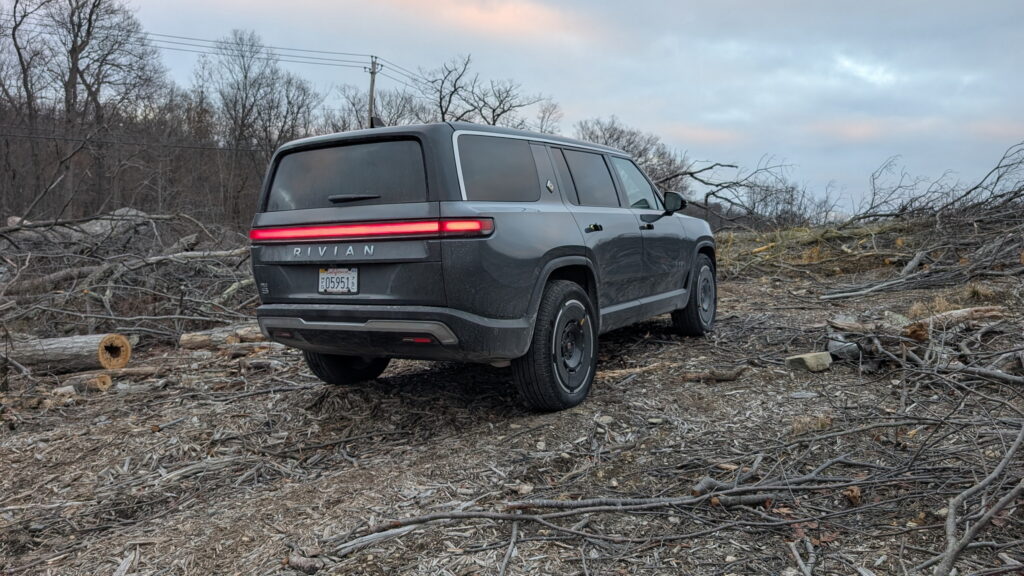
For example, in one trip that would take us 91 minutes and 59 miles according to Rivian’s in-car navigation, the R1S estimated we’d arrive at our destination with 144 miles of range. That’s all well and good, but according to the exact same screen at the exact same time, we had 213 miles of range available – so where are those extra miles going?
Consistently Inconsistent Range
That sort of behavior was very consistent. In another case, we left a charging station with 350 miles of estimated range to go to a destination just 39 miles away. I might have gone to school in Mississippi but even I can do the simple math on that one. We should’ve, in theory, had 311 miles remaining when we arrived. Instead, the R1S told us to expect to reach our destination with 274 miles of range remaining.
Despite this discrepancy, I’ll also make it clear that at no point did I have range anxiety or worry about charging despite not staying anywhere close to a charging station. In fact, I made it to my destination with 296 miles of range. That hasn’t always been my experience with electric SUVs either. Nevertheless, the R1S and R1T both have access to Tesla’s Supercharger network which makes charging up all over New York an absolute breeze.
In addition, Rivian’s own Adventure network wasn’t far off either and provided a great experience. Simply plug the charger into the car, confirm that the charge started, and walk away. There wasn’t any need to pull out a payment card, download some silly charging station app, or anything else. In reality, it was easier than pumping gas. Across all trips, we managed 2.67 kWh per mile, which is well within reason given the variables at play.
The Charging Experience
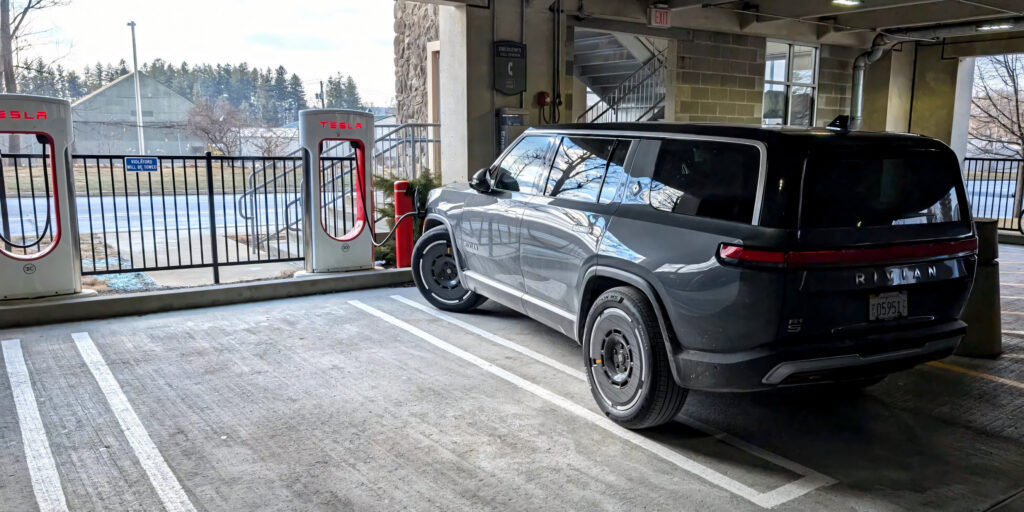
Charging itself was a bit of a mixed bag though. On the plus side, the R1S accepts up to 300 kW of charging speed, which meant I never needed to stay plugged in for hours at a time. In most cases, simply plugging it in for 30 minutes would be enough to pull the battery up to 80 percent or more. In one instance, the car went from 26 to 80 percent in 37 minutes on a Tesla Supercharger that had basically every other stall filled.
That charging excursion cost $46.06 by the way, which isn’t great compared to a gas car, but had we had the chance to charge at home it wouldn’t have even been close. The electric Rivian would’ve been colossally cheaper to run day in and day out and I would’ve never even needed to hit a public charging stall.
Speaking of stalls, that’s another concern that Rivian owners should consider. Charging at a Supercharger is easy and convenient aside from the physical position of the Rivian itself. Because the charge port is on the front driver’s side, the only way to avoid taking up an extra charging space is to park on the far left side of the row of chargers.
In any other space (save for some very creative parking on the far right side) you’ll take up an extra charging space. That can be uncomfortable when several drivers are waiting to use a charger for their EVs and you and your six-figure SUV have essentially iced one out til you’re done.
Interior Segment
While the cabin of a car is often just a place for spending time while occupied with the journey itself, the Rivain also has to house folks while they sit idling at a charger. To that end, the R1S is beautifully appointed with excellent attention to detail. As just one clear example, Rivian has possibly the most luxurious third row in the business when it comes to fit and finish. We’re getting a little ahead (or perhaps behind) ourselves though.
The dash is what most buyers will appreciate first. The real wood accents are a significant step above what you’ll find in a Tesla Model X, for example. The design is simple, elegant, and somewhat monolithic. It’s deeply consistent throughout the car too, which is somewhat rare. The huge panoramic glass roof makes the entire SUV feel more spacious even though it’s actually somewhat compact inside.
Seating in the R1S is comfortable, though not as adjustable as one might expect from a car in this price range. That said, it was great that we could move the middle row forward or back based on how many people were in the car at any given time.
Clever little touches like storage hooks, straps, and nets made carrying various items a breeze for everyone in attendance. The rear-seat infotainment system provides excellent functionality including heating for both the second and third-row seats, Bluetooth connectivity, lock functions, and a trip calculator so one’s passengers don’t have to ask how long it’ll be til we all arrive at our destination.
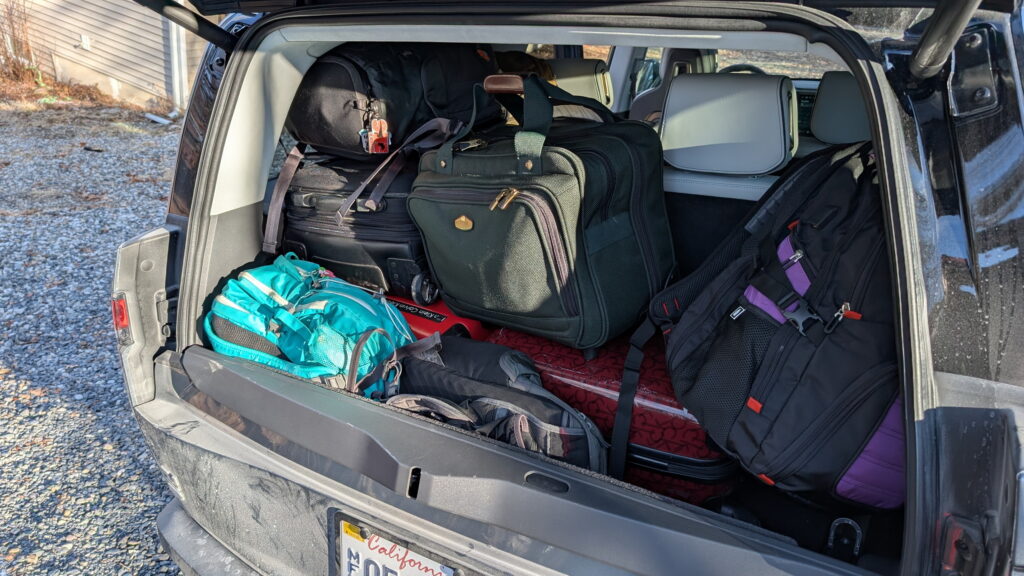
Finally, let’s chat about cargo because the R1S can hold so very much of it. On our excursion, we had five adults with at least two bags per adult, and all of them fit in the cabin along with all of the people without the need for us to stuff things in the front trunk.
Had we placed everything up front, it likely would’ve left us with essentially the entire cabin wide open. I hope we get a chance to test the new Quad Motor out in the middle of nowhere soon where I promise to take full advantage of all that storage.
Cabin Controls: Rivian’s Biggest Misstep
This might be the biggest gripe of the entire Rivian experience. The brand is dedicated to minimizing physical controls wherever it can. We asked them about their choices, including the one to not have physical climate controls, and they basically told us they didn’t want to hem themselves in with choices they could go back on.
For better or worse, this means that many functions are baked into the screen including the door lock and unlock mechanism, the heated seats, climate fan speed, and more. Changing the direction of airflow is a touchscreen setting. Moving the steering wheel requires hitting multiple buttons on the screen and then using the steering wheel rollers to position it. The same is true of the mirrors.
Speaking of that, the few buttons and switches that do exist aren’t all that great either. In fact, the switchgear feels cheap when compared to the rest of the cabin. The window switches also sit inside a big slab of plastic that isn’t very attractive. It seems odd that in these places where hands, wrists, and fingertips will interact often the surfaces and materials aren’t as high-end as the rest of the cabin.
Then, there’s the infotainment itself, which is a mixed bag. The graphics are crisp, bright, and even fun at times. The reactions are swift and some of the features are intuitively placed. On the flip side, there isn’t a way to leverage Android Auto or Apple CarPlay.
Bluetooth connectivity somewhat saves the day but the navigation system leaves one wanting for something a little smoother and a bit more polished. Picking a destination isn’t always easy to manage when the choices are a bit vague and changing or adding a direction mid-journey can be tough too. All of that said, it’s a solid system that we expect will only improve with time.
Headlights: The R1S’s Secret Weapon
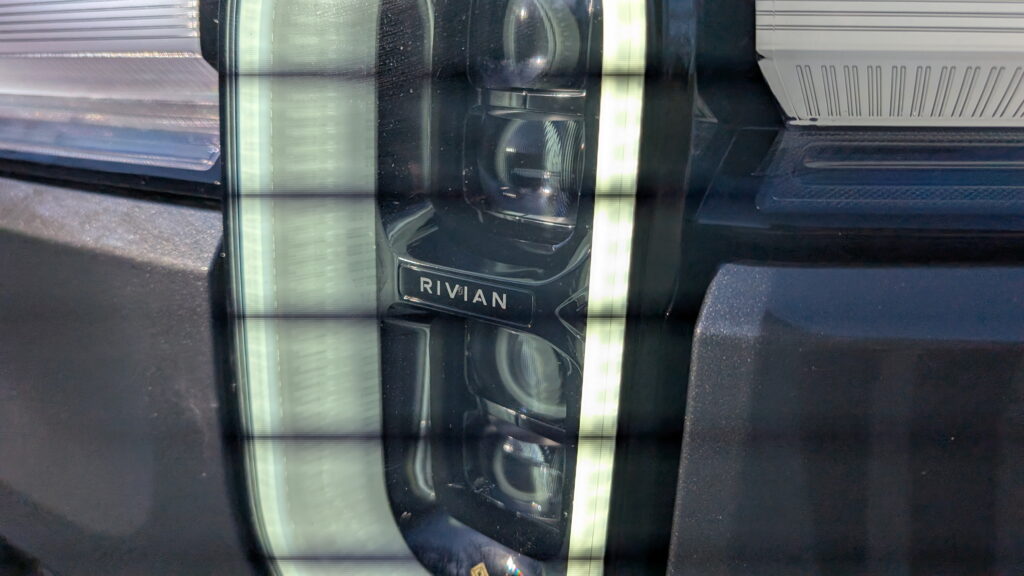
An entire section on headlights might sound odd but these are the very best I’ve ever used bar none. The gap between these headlights and the next best ones in my personal experience is so big that I can’t even remember who sits in second place. The R1S is the first car in the USA to use Adaptive Drive Beam technology and it deserves even more praise than I’m about to give it.
Known by many as Matrix LED lights, the headlight tech in the R1S enables almost fluid-like real-time adjustment based on traffic. For example, most of us have experienced the automatic bright light setting on modern cars. Once engaged (and that’s an important point we’ll return to), it basically scans the road at all times and then flips the brights off if it notices an oncoming car or that you’ve caught up to a car in the same lane but ahead of you.
Those automatic high beams are akin to a caveman when compared to the R1S’s Einstein-like lighting situation. Instead of just flipping full on or full off, the car can selectively turn off LED elements in the headlight to avoid blinding surrounding traffic. That’s right, it works in both directions too so when you come up behind someone the lights carve out a perfect little box for them so that you don’t blind that driver. The entire rest of the field of view remains lit up with high-beam light.
Even more impressive, when the driver is oncoming, the light dynamically carves out a space and moves that space as the driver gets closer and ultimately passes the R1S. Essentially, these headlights provide the absolute most light possible and never blind drivers around you. Maybe the best part though is that you don’t have to turn them on, as they are completely automatic.
Suffice to say, I hope more automakers adopt this technology as quickly as possible. Being able to see is clearly a paramount safety feature and these headlights make it easy.
Driving Experience: Power Meets Weight
Having driven several electric vehicles over the years, I had a good idea of what to expect from 665 horsepower (495 kW) and 829 lb-ft (1,122 Nm) of torque. What I didn’t appreciate before stomping on the go pedal in the R1S is just how adept this SUV is at doing sporty things despite its weight. Remember from our quick facts sheet that this three-row people hauler tips the scales at 6,331 pounds (2,871 kg).
That 665 horsepower is there just as much for just moving a beast this big as it is for performance, but it happily manages both. From a dig, the R1S feels a bit heavy off the line but it gathers speed at such a rapid pace that how heavy this thing is plays a role in making the experience feel all the more exotic.
In just 3.4 seconds you’ll go from not moving at all to hurtling down a road at 60 mph in something that weighs 1000+ pounds more than an adult male white rhinoceros. It’s like an unholy combination of a rhino and a cheetah and you’re at the helm – but that’s just the party trick.
It’s the rest of the driving experience that provides the clearest look at the depth and breadth of what Rivian has done here. For one thing, the R1S certainly doesn’t handle like I’d expect a rhino to. On the highway, it is calm, quiet, and serene. The adaptive cruise control and lane-keeping assist are accurate and smooth. The one-pedal driving mode takes a little getting used to, especially when traffic speeds are inconsistent, but it works great in predictable scenarios.
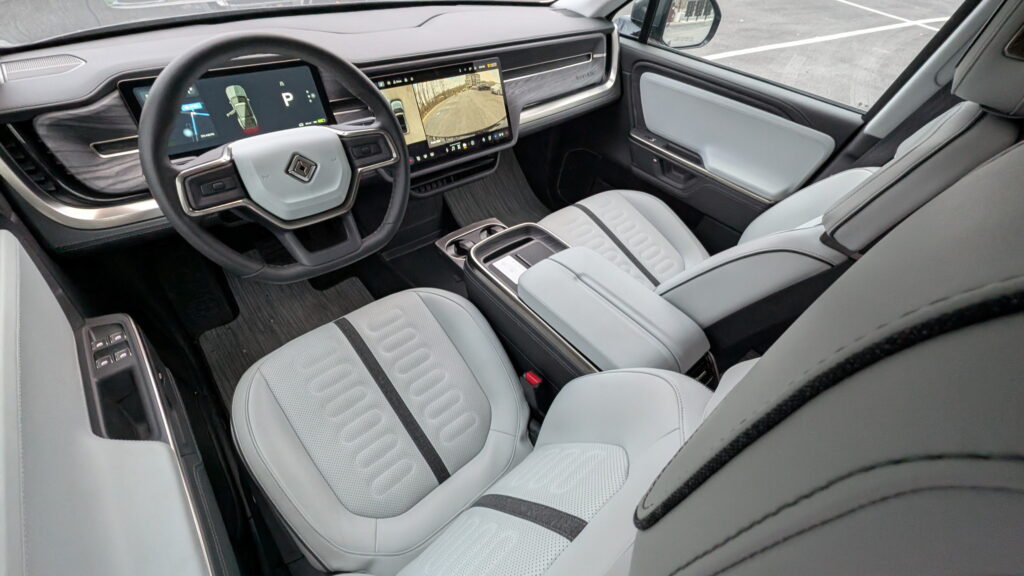
When needed, the brakes are strong and resilient. The steering is good too, with easy to perceive limits and clear communication without excessive vibration from the front tires. The two main areas of complaint in the R1S come down to the way it feels on occasion. Poorly maintained roads can cause a great deal more ride harshness than in any other six-figure SUV I’ve ever driven. Some of that is likely due to the gigantic 22-inch wheels and some could be related to the extremely heavy curb weight.
The other noticeable niggle was the aggressive nature of initial regenerative braking. Put simply, it’s harder than most of my passengers preferred. In inconsistent traffic, it actually made a couple of folks nauseous. Sure, it’s possible to reduce the force of regen braking in the R1S, but that means less range so you’ll have to make a trade-off one way or another. At the same time, it’s possible that having only a week to truly learn the system’s behavior wasn’t enough to get really adept at its use and that more time would’ve resulted in a smoother experience for everyone onboard.
Competition
When the R1S first arrived on the scene it was basically only rivaled by the Tesla Model X which is faster and better to drive on the road. Where Rivian beat the Tesla was off-road and in terms of overall range. Today, the Model X is the one trying to keep up as Rivian is set to launch a Quad Motor R1S this year that’ll likely smoke the Tesla on the road and continue its dominance when the pavement runs out.
Where the Rivian is going to struggle most though is against new competition from Kia, Hyundai, Volvo, and BMW. For example, the Kia EV9 offers more interior space, tons of technology, and a much lower base price. Sure, it misses out on the power and luxury features of the Rivian, but saving tens of thousands of dollars is enough for many buyers to overlook that.
The Ioniq 9 might just be the perfect blend since it leverages more luxury appointments. The BMW iX could be a good option too thanks to its supremely good on-road manners. Of course, none of these competitors offer the off-road chops of the Rivian and that’s a key selling feature that the brand leans on.
Those who value supreme off-road capability over all else might be willing to cross-shop the GMC Hummer EV SUV since it has a similar price tag and even more impressive overlanding features. The Rivian is still the more practical choice between the two for now.
Final Thoughts
It’s hard not to like the Rivian R1S after spending time in. Note that I didn’t say love, though. It is expensive and that feels like a very important aspect of it when considering how it sometimes rides rough and that other three-row electric SUVs offer much of the same experience for far less cash.
Nevertheless, technology often trickles downhill over time and that’s what makes the R1S so exciting. No other electric SUV on sale at this price point offers the mix of capabilities that this one does. It’s very comfortable in most circumstances. It handles well. It’s full of useful features. It’s sincerely good off-road. The cabin feels very high-end. And it has more than enough range for the average everyday user. No, it’s not perfect, but the issues it comes with are mostly those associated with production by a relatively new manufacturer.
Give Rivian time to continue honing its craft, find new economies of scale it can pass on to the customer, and improve a few dynamics. If it does all that, there’s little doubt that it’ll be a major player in this space and one for other companies to continue to mimic in the years to come.



